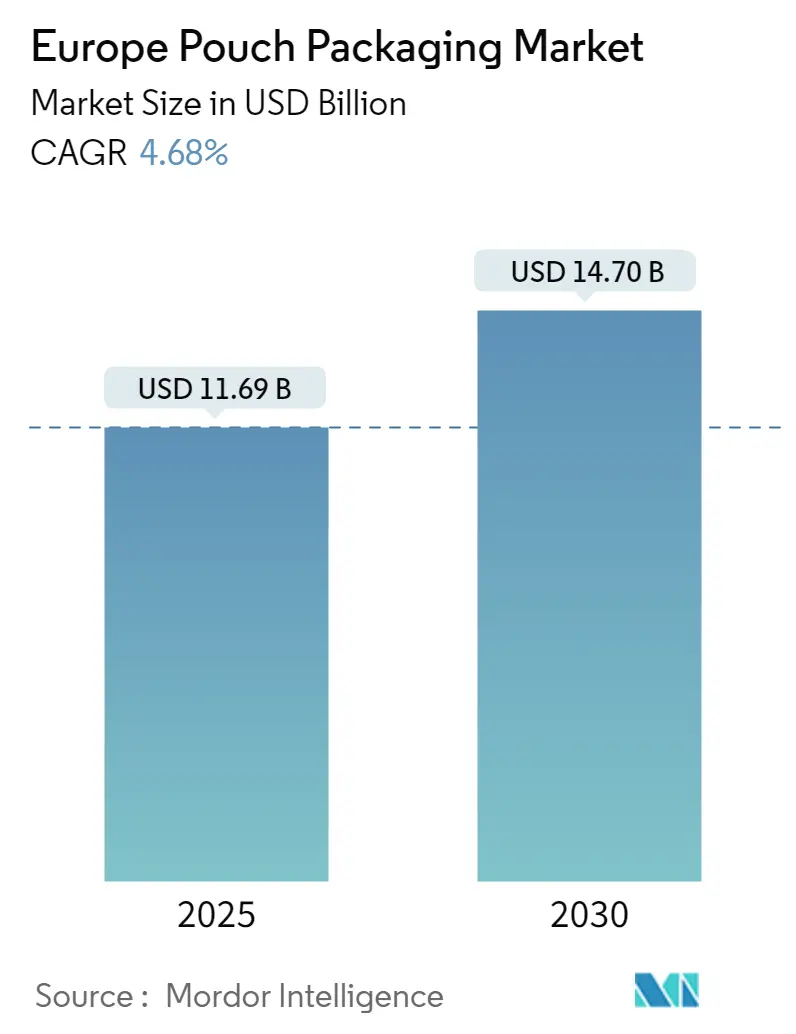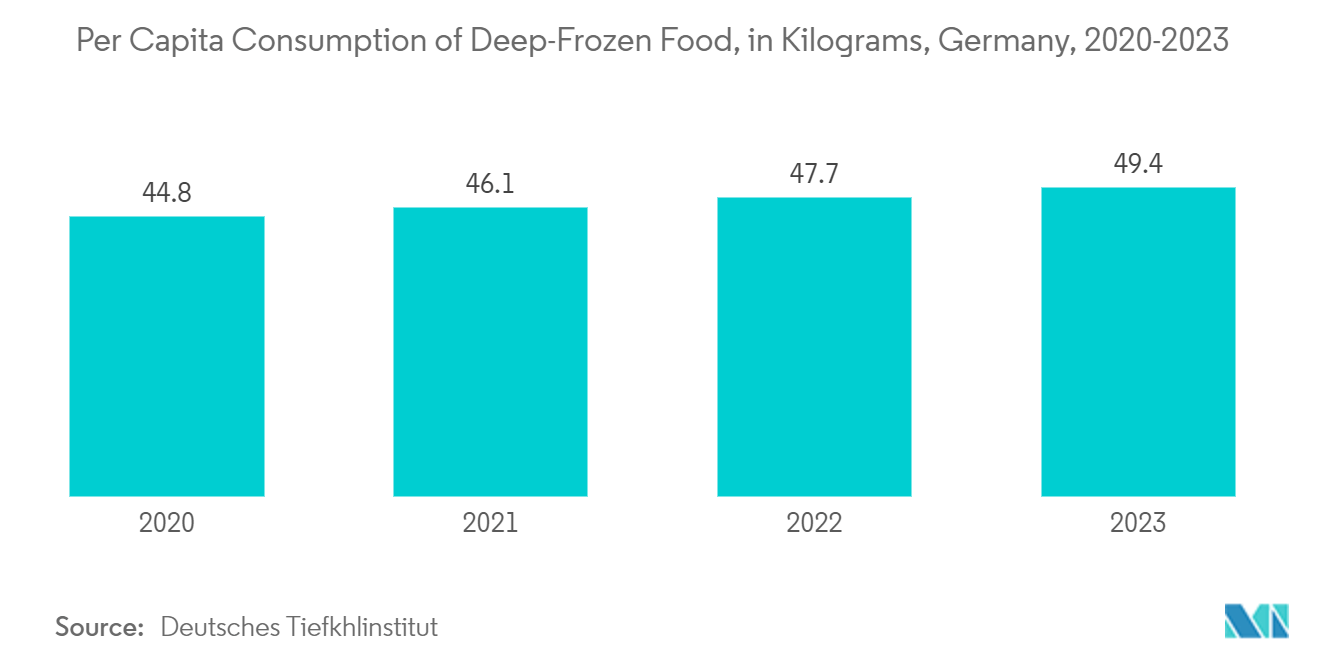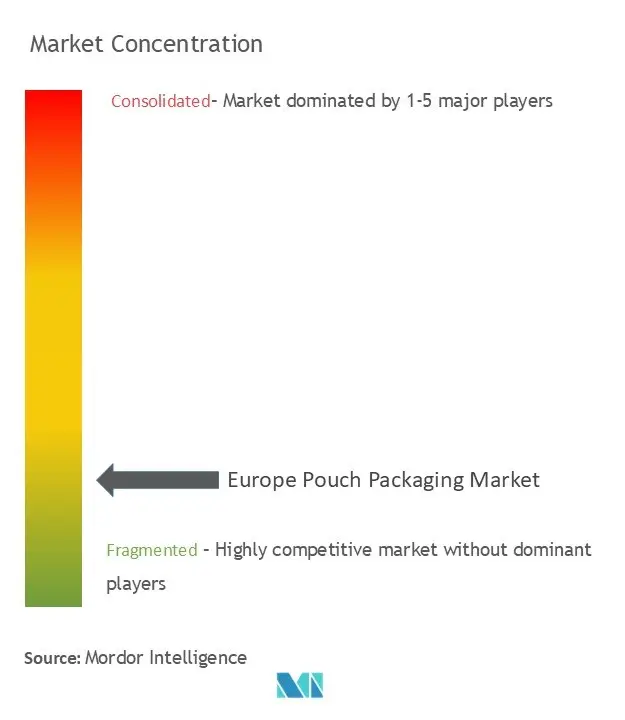
| Study Period | 2019 - 2030 |
| Base Year For Estimation | 2024 |
| Forecast Data Period | 2025 - 2030 |
| Market Size (2025) | USD 11.69 Billion |
| Market Size (2030) | USD 14.70 Billion |
| CAGR (2025 - 2030) | 4.68 % |
| Market Concentration | Low |
Major Players
*Disclaimer: Major Players sorted in no particular order |
Europe Pouch Packaging Market Analysis
The Europe Pouch Packaging Market size is estimated at USD 11.69 billion in 2025, and is expected to reach USD 14.70 billion by 2030, at a CAGR of 4.68% during the forecast period (2025-2030).
- Pouch packaging, comprising materials like metal foil, plastic, and occasionally paper, is a prevalent single-use solution. It boasts dispensing features such as resealable spouts and squeeze pouches, enhancing user convenience and driving the market's growth. The rising consumption of convenience foods in Europe is a primary driver for the pouch packaging market. Pouches' resealable nature allows for portion control, catering well to on-the-go lifestyles.
- The lightweight design of pouch packaging has positioned it as a popular alternative to traditional rigid materials like glass or metal in various industries. This lightweight nature not only makes pouches more accessible but also reduces material consumption during production, leading to cost savings. Particularly beneficial for snacks, beverages, and personal care items, the reduced weight of pouches is a significant advantage.
- However, sustainability poses a pressing challenge in Europe. The European Environment Agency reports a staggering 2.2 billion tonnes of annual waste in the EU. A key drawback of pouches is their limited recyclability, often stemming from their multi-layered composition, which includes plastics, aluminum, and other hard-to-recycle materials. This complexity hampers traditional recycling efforts, potentially leading to environmental issues if non-recycled pouches end up in landfills.
- Moreover, pouches, primarily designed for single or limited uses, fall short in long-term sustainability compared to rigid packaging. Tackling these sustainability challenges demands material innovation, improved recycling processes, and stringent regulatory actions to align pouch packaging with eco-friendly standards.
- In Europe, pouch pricing strategies are intricately tied to raw material costs, especially polymers and laminates. Fluctuations in material prices, often influenced by factors like petroleum costs and supply chain disruptions, directly impact pouch pricing dynamics. To navigate this volatility and stay competitive, manufacturers are increasingly turning to strategic sourcing, cost optimization, and exploring innovative material alternatives.
Europe Pouch Packaging Market Trends
Increasing Consumption of On-The-Go Food is Set to Drive the Market Forward
- The pouch packaging market in Europe is witnessing a surge, propelled by the growing consumption of frozen foods. This uptick is largely attributed to the modern lifestyle's emphasis on convenience, driven by increasingly busy schedules. The British Frozen Food Federation (BFFF) reported a notable 13.5% surge in retail frozen food sales and post-pandemic, underlining a clear consumer shift toward processed foods. With the demand for frozen and ready-to-eat meals on the rise, the pouch packaging industry is poised for continuous innovation to cater to the evolving needs of consumers and manufacturers.
- Packaging frozen foods in pouches now incorporates advanced barrier materials and structures. These barriers are meticulously designed to offer enhanced protection against moisture, oxygen, and light. By creating a controlled environment, these pouches effectively maintain the quality, flavor, and texture of frozen foods over prolonged periods.
- Recent advancements in pouch design have introduced microwavable and freezer-safe variants. These pouches are engineered to withstand extreme temperatures while retaining their integrity. Additionally, vacuum-sealed pouches are gaining traction in frozen food applications. This method removes air, reducing the risk of freezer burn and ensuring prolonged freshness.
- Pouch packaging offers a canvas for branding, allowing for a prominent display of logos, brand colors, and taglines. Strong branding not only engages consumers but also plays a pivotal role in their purchasing decisions, especially in a fiercely competitive market. Furthermore, visually appealing graphics aid in establishing brand recognition on store shelves. With technologies like high-resolution digital and flexographic printing, brands can now craft intricate and detailed designs, enhancing the overall consumer experience.
- The European Union's (EU) Packaging Regulation, with a focus on reducing waste and promoting recycling, is set to undergo a significant transformation with the proposed Packaging and Packaging Waste Regulation (PPWR) in 2023. The PPWR targets complete recyclability for all packaging by 2030, with at-scale recycling anticipated by 2035. Additionally, it aims for a 15% per capita reduction in packaging waste by 2040, compared to 2018 levels. To achieve these goals, governments and regulatory bodies are rolling out measures like extended producer responsibilities (EPR) and plastic waste reduction targets. This push toward sustainability is not only reshaping the packaging landscape but also fueling innovation.
- Rising consumer awareness and environmental consciousness are driving a surge in demand for sustainable packaging solutions. Consequently, there's a notable uptick in investments and innovations, particularly in the development of mono-material pouches. These pouches are gaining favor for their ability to address sustainability and recycling challenges. By simplifying the recycling process and aligning with existing systems, mono-material pouches are paving the way for closed-loop recycling, where the material is reused to create new pouches.
- According to a report by Salone Internazionale del Biologico e del Naturale (SANA) in September 2023, major grocery retail chains in Italy dominated nearly half of the organic sales in 2023. This growing preference for organic consumer packaged products is reshaping the demand landscape for pouch packaging, with consumers increasingly favoring sustainable and eco-friendly options.

Germany is Anticipated to Witness the Highest Growth During the Forecast Period
- Urban German consumers, leading hectic lives, are increasingly favoring on-the-go food options, propelling demand in the packaging sector. Pouch packaging, ideal for snacks, sauces, and ready-to-eat meals, is a go-to choice. Notably, premium and artisanal food brands leverage pouches for their design flexibility, resonating with German consumers' penchant for quality and authenticity. This surge in demand for convenience and delicatessen foods is a key driver behind the pouch packaging market's growth.
- The European pharmaceutical sector is on a rapid growth trajectory, buoyed by shifting demographics, a surge in chronic ailments, and a rising focus on prevention and self-medication. Germany, a global clinical trial hub, stands out in Europe for its pharmaceutical innovation, which is marked by robust R&D investments and patent applications.
- As Germany solidifies its position as the world's second-largest medicinal products exporter and a top pharmaceutical producer, pouch packaging is taking center stage. Pouches not only ensure medication sterility and safety but also meet stringent regulatory standards, aid in precise dosage compliance, and enhance patient convenience. Moreover, their lightweight nature and cost-effectiveness align well with the pharmaceutical industry's sustainability goals.
- The German Federal Ministry for the Environment, Nature Conservation, Nuclear Safety, and Consumer Protection (BMUV) has unveiled a key issues paper highlighting a new law aimed at curbing packaging waste. The law targets excessive single-use packaging, which is especially prevalent in the food sector.
- Notably, supermarkets and discounters with over 200 m² of sales area will be mandated to offer at least one multi-use bottle product for select beverages, including water, beer, soft drinks, juice, and milk. Additionally, the law proposes a blanket ban on single-use packaging for on-site consumption, aiming to combat the trend of food being served and consumed in single-use packaging, leading to unnecessary waste. These sustainability initiatives are not only driving innovations but also spurring new product developments.
- As per a report by the Deutsches Tiefkühlinstitut, in 2023, the per capita consumption of frozen foods in Germany rose to 49.4 kilograms, indicating a growing appetite for frozen products. This uptick in frozen food consumption is directly boosting the demand for pouch packaging solutions, known for their convenience, functionality, and preservation attributes, thereby bolstering the pouch packaging market in the region.

Europe Pouch Packaging Industry Overview
The European pouch packaging market is fragmented due to the presence of several market players globally. Some major players are Amcor PLC, Bischof+Klein SE & Co. KG, AluFlexpack Group, Mondi Group, and Constantia Flexibles Group GmbH. The market players are expected to leverage the opportunity posed by the growth of several end-user verticals and are innovating to expand their market presence.
- June 2023 - Constantia Flexibles acquired Drukpol Flexo, a packaging company in Poland, to strengthen both the companies’ global reach and innovate a more sustainable product portfolio by investing in the growth of the European Flexo printing platform.
- April 2023 - AluflexPack Group launched a recyclable mono PP spouted pouch, which offers a high barrier for oxygen and water vapor, making it suitable for shelf-stable products that undergo hot filling and pasteurization such as baby food and fruit puree, cold filled, or dairy applications.
Europe Pouch Packaging Market Leaders
-
Amcor Group GmbH
-
Bischof+Klein SE & Co. KG
-
AluFlexpack Group
-
Mondi Group
-
Constantia Flexibles Group GmbH
- *Disclaimer: Major Players sorted in no particular order

Europe Pouch Packaging Market News
- March 2024: Capri Sun Group, a German-based juice brand, launched a recyclable, mono-polypropylene drinks pouch with an aim to reduce CO2 emissions by 25% compared to its previous design and support the brand’s mission to adopt fully recyclable packaging.
- March 2024: PepsiCo, in collaboration with its partners in the flexible food packaging supply chain, introduced a novel premium snack packaging. This innovative packaging, which boasts 50% recycled plastic content, not only meets rigorous food-contact standards but also marks a significant step toward sustainability. Initially rolled out for PepsiCo's Sunbites brand, the packaging made its debut in the United Kingdom and Ireland in late 2023.
Europe Pouch Packaging Industry Segmentation
The market study tracks the demand for pouch packaging in different end-user verticals like food, beverages, pet food, cosmetics, and pharmaceuticals. The pricing for the raw material, that is, plastic, paper, and metal, is taken into consideration along with the consumption, import, and export trends and average prices to arrive at the market revenue.
The Europe Pouch Packaging Market is Segmented by Material Type ( Paper, Plastic and Aluminum), by Resin Type - Plastic ( Polyethylene, Polypropylene, PET, PVC, EVOH, Other Resins), by Product ( Flat ( Pillow and Side Seal), Stand Up), by End-User Industry (Food (Candy & Confectionery, Frozen Foods, Fresh Produce, Dairy Products, Dry Foods, Meat, Poultry, And Seafood, Pet Food, Other Food Products (Seasonings & Spices, Spreadables, Sauces, Condiments, etc.)), Beverage, Medical and Pharmaceutical, Personal Care and Household Care, and Other End-User Industries) and Country (France, Germany, Italy, United Kingdom, Spain, Poland, Nordic and Rest of Europe).The report offers market forecasts and size in value (USD) for all the above segments.
| By Material | Plastic | Polyethylene | |
| Polypropylene | |||
| PET | |||
| PVC | |||
| EVOH | |||
| Other Resins | |||
| Paper | |||
| Aluminum | |||
| By Product | Flat (Pillow & Side-Seal) | ||
| Stand-up | |||
| By End-User Industry | Food | Candy & Confectionery | |
| Frozen Foods | |||
| Fresh Produce | |||
| Dairy Products | |||
| Dry Foods | |||
| Meat, Poultry, And Seafood | |||
| Pet Food | |||
| Other Food Products (Seasonings & Spices, Spreadables, Sauces, Condiments, etc.) | |||
| Beverage | |||
| Medical and Pharmaceutical | |||
| Personal Care and Household Care | |||
| Other End user Industries ( Automotive, Chemical, Agriculture) | |||
| By Country | France | ||
| Germany | |||
| Italy | |||
| United Kingdom | |||
| Spain | |||
| Poland | |||
| Nordic | |||
| Rest of Europe | |||
Europe Pouch Packaging Market Research FAQs
How big is the Europe Pouch Packaging Market?
The Europe Pouch Packaging Market size is expected to reach USD 11.69 billion in 2025 and grow at a CAGR of 4.68% to reach USD 14.70 billion by 2030.
What is the current Europe Pouch Packaging Market size?
In 2025, the Europe Pouch Packaging Market size is expected to reach USD 11.69 billion.
Who are the key players in Europe Pouch Packaging Market?
Amcor Group GmbH, Bischof+Klein SE & Co. KG, AluFlexpack Group, Mondi Group and Constantia Flexibles Group GmbH are the major companies operating in the Europe Pouch Packaging Market.
What years does this Europe Pouch Packaging Market cover, and what was the market size in 2024?
In 2024, the Europe Pouch Packaging Market size was estimated at USD 11.14 billion. The report covers the Europe Pouch Packaging Market historical market size for years: 2019, 2020, 2021, 2022, 2023 and 2024. The report also forecasts the Europe Pouch Packaging Market size for years: 2025, 2026, 2027, 2028, 2029 and 2030.
Europe Pouch Packaging Industry Report
Statistics for the 2025 Europe Pouch Packaging market share, size and revenue growth rate, created by Mordor Intelligence™ Industry Reports. Europe Pouch Packaging analysis includes a market forecast outlook for 2025 to 2030 and historical overview. Get a sample of this industry analysis as a free report PDF download.




